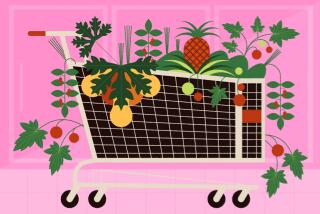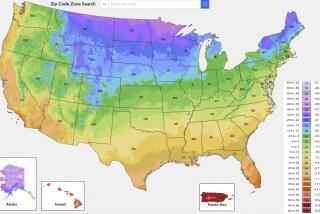U.S. Wants to Put Better Peas in the Pot
- Share via
CHARLESTON, S.C. — The government wants to put a better pepper in every pot. And better peas and sweet potatoes too.
The U.S. Vegetable Laboratory was established 57 years ago to develop vegetables resistant to insects, weeds and disease. But that’s not why the mail started pouring in.
No, the mail started streaming in due to the Charleston Hot pepper.
Earlier this year, the lab released seeds for the peppers, which are resistant to worms that eat plant roots. The resistance part was nice, sure, but people flocked to it because it was spicy hot.
After the government issued a news release, the lab was inundated with orders and ran out after mailing 10,000 Charleston Hot seed packets to everyone from back yard gardeners to seed companies.
Then it mailed 8,000 more packets of Carolina Cayenne, a similar, but larger, pepper developed seven years ago with little fanfare.
Usually, the lab gets about 100 requests a year for newly developed seeds, mostly from seed companies that want to develop their own hybrids.
Why was Charleston Hot such a hot item, even though other peppers are hotter?
“There is so much interest in hot sauces, we just didn’t fathom how much there would be,” said Philip Dukes, one of two scientists who worked 12 years developing the pepper.
“Our mission is to solve the problems of the American farmers,” said Richard Farey, the other researcher who helped develop it. “We don’t get any royalties.”
The lab, the government’s largest vegetable research center, sprawls across 440 acres of fields, pine stands and marsh just west of Charleston.
Fifty scientists toil in the labs, greenhouses and test plots to grow hybrids of 26 different vegetables. The fields are some of the oldest in cultivation in the nation, dating to a Colonial plantation.
Other successes over the years include the Homestead tomato, developed during the 1960s. Since the strain won’t easily spoil, that allowed tomatoes to be shipped long distances for the first time.
The lab came up with the Charleston Gray watermelon too. Most world watermelon production was Charleston Gray until a few years ago. Now more hybrids are used, but many draw on the disease-resistant Gray, said Claude Thomas, the lab’s director.
In the 1970s, when people were waiting in gas lines, the lab developed a sweet potato called HiDry, which is about 40% starch, for use in gasohol and other industrial products.
The names of new varieties generally are based on traits of the vegetables--Charleston Gray, for instance, has a gray-green tint on the outside. Any name for a new hybrid must be unique.
The government originally chose Charleston for the lab because plant diseases and numerous insects thrive in the warm, humid summers and mild winters.
Scientists propagate vegetables the old-fashioned way, crossing strains and then growing offspring. New varieties take eight to 10 years to develop, and the lab releases three or four a year.
The work has taken on new importance as farmers move away from using pesticides on their crops, but the development of a disease-resistant vegetable doesn’t mean you’ll always find them at the greengrocer.
Scientists also must consider flavor, appearance, shape, sprouting ability and about 20 other characteristics, Dukes said.
Scientists already know of a hardy sweet potato that is native to Central America, for example, but would grow well in the South. The problem is that the inside is purple. No one will eat a purple sweet potato, Dukes said.
More to Read
Sign up for Essential California
The most important California stories and recommendations in your inbox every morning.
You may occasionally receive promotional content from the Los Angeles Times.









